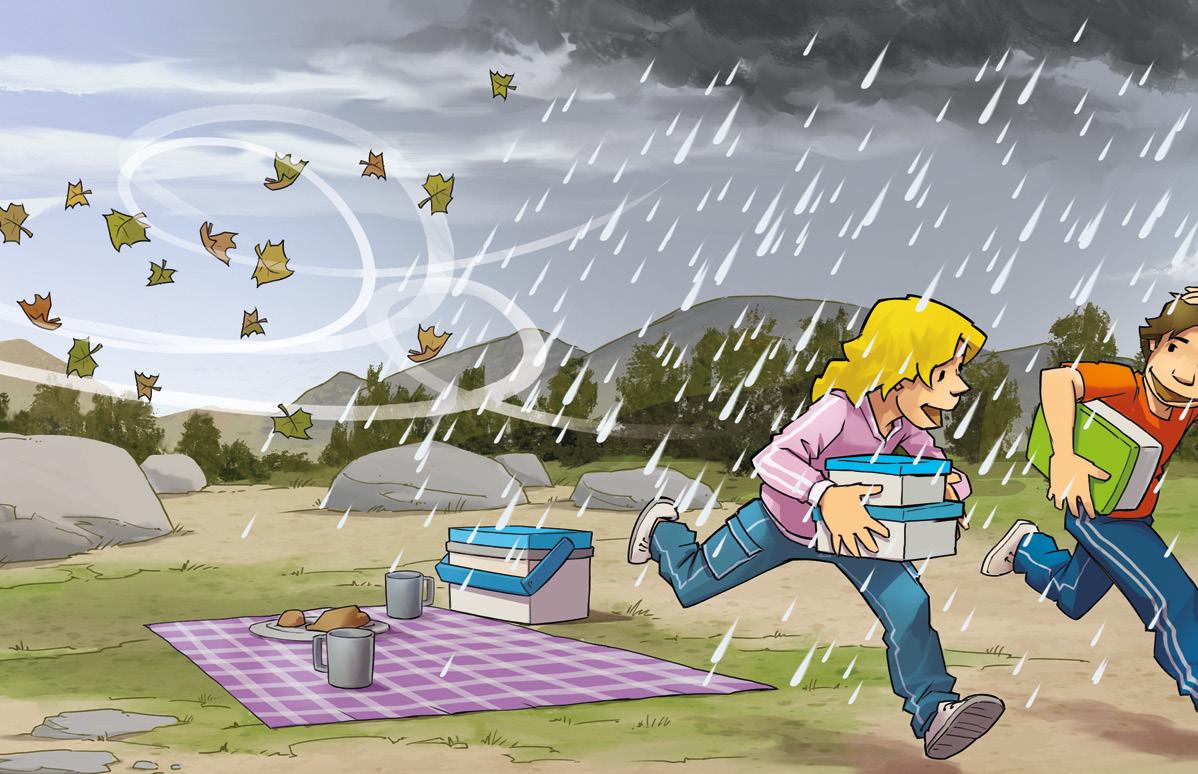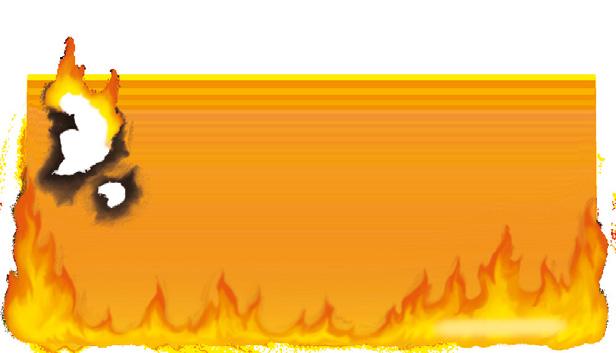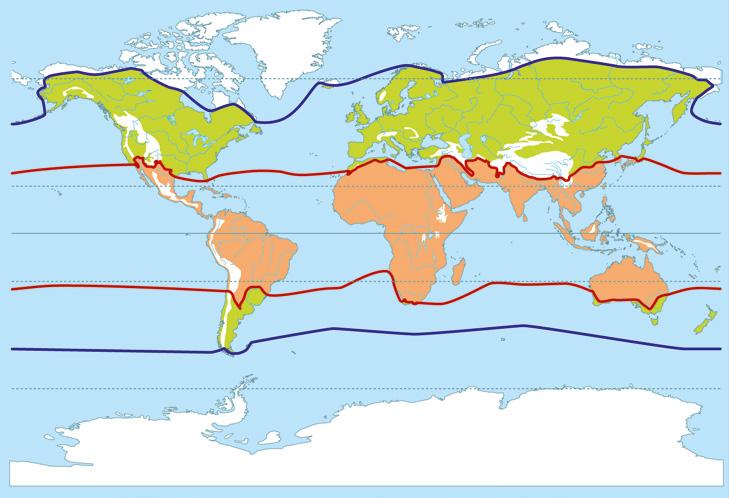
5 minute read
1 Where do fires do the most damage?
"Spain had the worst fire season of the century in 2022. Forest fires destroyed around 300,00 hectares.". The day after reading the news, Laura came to class to discuss it with her teacher. Her grandfather lives in Zamora, the province worst affected by the fires, and has lost some of his property. She wants to understand how this happens and, most of all, if there is anything she can do to prevent a situation like this in the future.
What do you think?
Why do you think forest fires happen? Do you think they are natural or provoked? What action is taken to prevent them? What are the consequences?
Context
In this unit...
Target in action
Record a video talking about the increase in fires and giving advice on how to prevent fires in our local countryside.
The General Directorate for Civil Protection and Emergencies of the Ministry of the Interior says that 95 % of forest fires are caused by people, who are not careful.
Follow the thread!
The

atmosphere and atmospheric phenomena
1
Why do we check the weather forecast every day?
The climate
2
What weather elements can influence fires to spread?
Climates in Spain
3
Which areas of Spain are most at risk from fires?
4
The climographs We show the climate
Climate and landscape
5
Which landscapes are most affected by fires?

Climate change and GITs
6
We study how the climate is changing
Why do we check the weather forecast every day?

The weather affects our everyday life. It tells us what type of clothes to wear, if we will need an umbrella, sunglasses...
Why is the atmosphere so important?
The atmosphere is the layer of gases surrounding the Earth, primarily nitrogen, oxygen and carbon dioxide. It is essential for life to exist on our planet because:
• It filters dangerous solar radiation.
• It regulates the planet's temperature, making it habitable.
• It contains gases necessary for breathing and photosynthesis of living beings (oxygen and carbon dioxide).
Atmospheric phenomena
Atmospheric phenomena are things that happen naturally in the atmosphere: wind, clouds, precipitation, etc.
To find a summary of the unit, watch the video 'Let me tell you' on anayaeducacion.es
The air in the atmosphere moves because of temperature changes, resulting in wind
How is the weather?
Atmospheric phenomena determine atmospheric or meteorological weather , understood as the state of the atmosphere at a time and place.
Atmospheric weather changes a lot and we study it in meteorology . The aim of meteorology is to forecast the weather in 24 or 48 hours and to produce a short or medium-term weather forecast.
We see analysis and predictions everyday in meteorological maps or weather maps
One of the most special atmospheric phenomena is the rainbow. Rainbows happen when it rains and the raindrops act as mirrors, dispersing and splitting the light. Polar auroras is another, which you can only see at specific locations on the planet. They are the result of the interaction of the earth's magnetic poles and particles transported by solar wind.

1 Write around List the reasons why the atmosphere is important for living things.
2 Which atmospheric phenomenon is this?
• It is formed because of the condensation of water droplets in the atmosphere.
• Condensed water in the clouds comes down to the surface.
• Movement of the air in the atmosphere.
3 What makes you say that? Look at the weather map and describe the weather in your region.

Take note!
Recently, there is more extreme atmospheric or meteorological phenomena such as snowfalls, heat waves, torrential rain, tornadoes, etc.
What weather elements can influence fires to spread?
What data should be considered when defining a high-risk fire area?
What is climate?
Climate is a set of frequent atmospheric conditions at a particular location that is determined after a study of the atmospheric weather in that area over several decades. This study helps establish the frequent behaviour of atmospheric phenomena at a particular location.
Weather elements
Weather elements are the set of components that characterise the atmospheric weather and how they interact with each other. They are essential for reliable weather forecasting.

Weather elements
Temperature . This is the quantity of heat energy accumulated in the atmosphere. It is measured in degrees Celsius (ºC), with a thermometer
Precipitation . This is water falling on the earth's surface. It can be in a liquid or solid state. It is measured in litres per m 2 with the rain gauge
Humidity. This is the quantity of water vapour in the atmosphere. The higher the temperature, the lower the humidity. It is measured with the hygrometer
1 Name the weather elements and the instruments used to measure each of them.
2 Pencils in the middle What are climatic factors? Name the ones that you think influence where you live and which ones do not.
3 Create your own weather station in class.
Cloud cover . It is the quantity of clouds.
Wind . This is the movement of air in the atmosphere. Its speed is measured with the anemometer, in metres per second (m/s), and its direction is shown by a wind vane
Atmospheric pressure
This is the weight that a mass of air presses on the earth's surface. It is measured in millibars, using a barometer
Climatic factors
Climatic factors are the climatic conditions of a specific area. Depending on these factors, the elements of the climate will be different and so will the climate.
To learn more about meteorological elements, watch the video "The weather station" on anayaeducacion.es.


The temperature reduces by 1 °C for every 100 metres of altitude.
This is the distance from any point on Earth to the equator or 0 ° parallel. The climate of an area is warmer when it is closer to the equator and colder when it is further away.
This is the height that any surface reaches above sea level. Altitude affects temperatures: the higher the altitude, the lower the temperature.

The water in the seas and oceans warms slower than the land, so it regulates the temperature of nearby areas, making them less extreme. The influence of the sea also affects wind and humidity.
Relief is the diversity of shapes that the earth's crust forms, such as mountain ranges, plains, valleys, etc. The climate in mountainous areas will be different from lowland areas.

Which areas of Spain are most at risk from fires?
Not all parts of Spain have the same climate, so the risk of fire varies.
Climates of Spain
Spain is in the temperate climate zone of the Earth, because of its latitude.
All the climatic factors mentioned mean that Spain has a characteristic climatic diversity.
Climate and fire

The continental climate covers most of the peninsular surface. Temperatures are extreme, very cold in winter and very hot in summer, because of the limited influence of the sea. Precipitation is abundant in autumn and spring, sometimes torrential, and very low in summer.

In the southern sub-plateau and a large part of Andalucía there is a variety, the continentalMediterranean climate , with less extreme temperatures.

The oceanic climate is found in the north of the peninsula. Its main characteristic is cool temperatures in winter and mild in summer. Precipitation is abundant throughout the year, but less in summer.
1 Draw a map of the climatic zones of Spain in your notebook.

2 What is the climate in the area where you live? What are its characteristics?
The mountain climate is found in high mountain areas. Temperatures are normally cold, even in summer, and go below freezing in winter. Precipitation is frequent, and snow falls in winter.
The subtropical climate in Spain is found in the Canary archipelago, because of its geographical location closer to the warm zone. Temperatures are usually warm all year and there is little difference between summer and winter. Precipitation is low, but higher in the northern islands than in the south.
The Mediterranean climate is located in the coastal areas of the south and east of the peninsula. This climate has mild temperatures in winter and hot temperatures in summer, more than 2730 °C. Precipitation is irregular, mostly in spring. Precipitation can also be torrential.
Take note!







